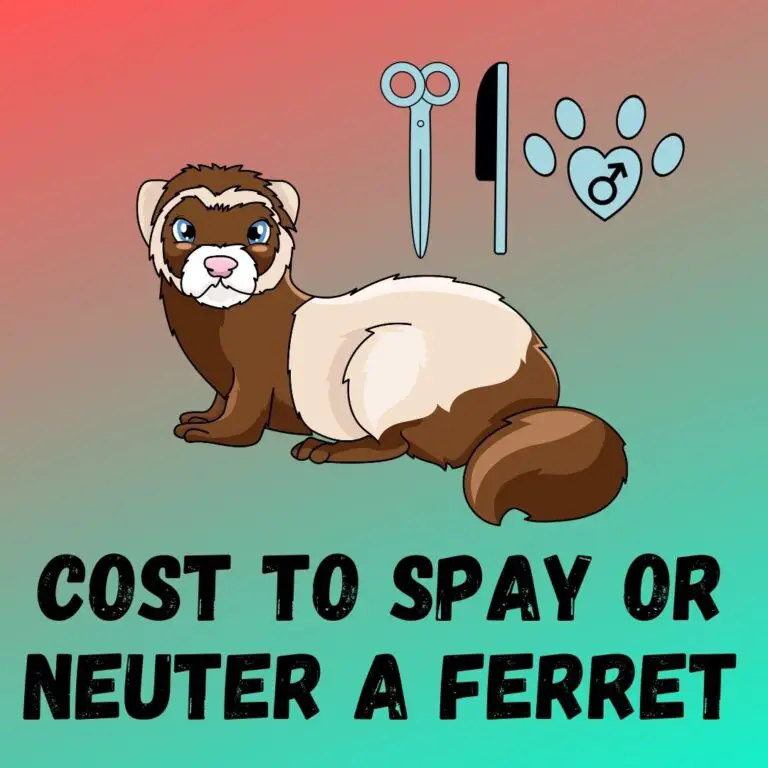
If you’re considering bringing a ferret into your home, it’s important to make sure your space is safe and secure for these curious little creatures. Ferrets are notorious escape artists and can easily get into trouble if not properly contained. In this article, I’ll share some valuable tips and tricks on how to ferret-proof your home and yard, ensuring that your furry friend stays out of harm’s way.
When it comes to ferret-proofing, prevention is key. These mischievous critters have a knack for finding small spaces to squeeze through, so it’s important to thoroughly inspect your home for any potential escape routes. From blocking off crawl spaces and sealing gaps under doors, to securing windows and covering vents, I’ll guide you through the necessary steps to create a safe and secure environment for your ferret.
Key Takeaways
- Thoroughly inspect your home for potential escape routes such as crawl spaces, doors and windows, vents and pipes, and furniture and decorations.
- Block off crawl spaces using sturdy materials like wire mesh or plywood to prevent your ferret from escaping.
- Seal gaps under doors using weatherstripping, door sweeps, or foam or caulk to eliminate potential escape routes.
- Secure windows with screens, locks, and window coverings to prevent your ferret from squeezing through or opening them.
- Cover vents with vent covers or grates and seal any gaps around them to prevent your ferret from escaping or accessing dangerous areas.
- Regularly inspect and maintain all protective measures to ensure they remain effective in keeping your ferret safe and secure.
Inspecting Your Home for Escape Routes
One of the first steps in ferret-proofing your home and yard is to thoroughly inspect your living space for any potential escape routes. Ferrets are known to be incredibly curious and agile creatures, capable of squeezing through even the tiniest openings. Ensuring that your home is secure will prevent any escape attempts and keep your furry friend safe.
Here are some key areas to focus on when inspecting your home for potential escape routes:
- Crawl Spaces: Ferrets are notorious for finding their way into tight spaces. Inspect the areas under your furniture, appliances, and cabinets. Block off any openings or gaps with baby gates, wooden boards, or other sturdy materials that your ferret won’t be able to push through.
- Doors and Windows: Check all doors and windows in your home for gaps or openings. Install weatherstripping or draft guards to seal any gaps beneath the doors. Use window screens or install window locks to prevent your ferret from nudging them open.
- Vents and Pipes: Inspect the vents and pipes in your home to make sure they are secure. Cover any vents with mesh or grates that are resistant to chewing. Use pipe insulation or covers to prevent your ferret from squeezing through any small openings.
- Electrical Cords and Wires: Ferrets are known to be attracted to electrical cords and wires, which can be dangerous if chewed on. Secure loose cords against walls or furniture using cord clips or covers. Consider using cord covers or cord protectors to deter your ferret from chewing on them.
- Furniture and Decorations: Take extra care in inspecting your furniture and decorations. Look out for any holes or gaps that your ferret could crawl into. Consider blocking off any inaccessible areas with furniture or decorative barriers.
By thoroughly inspecting your home for potential escape routes, you can create a safe and secure environment for your curious ferret. Remember, prevention is key when it comes to ferret-proofing, so take the necessary steps to eliminate any potential risks. With a little extra effort, you can ensure that your furry friend remains happy and secure in their new home.
Blocking Off Crawl Spaces
When it comes to ferret-proofing your home, one area that requires special attention is Blocking Off Crawl Spaces. These small spaces can be incredibly tempting for your furry friend to explore, and it’s important to ensure that they are securely sealed off to prevent any potential escapes.
Here are a few tips and tricks to help you effectively block off crawl spaces and keep your ferret safe:
- Inspect the area: Start by thoroughly inspecting the crawl spaces in your home. Look for any small gaps or openings that your ferret could squeeze through. Keep in mind that these curious creatures can fit through surprisingly tight spaces, so pay attention to even the smallest openings.
- Seal any gaps: Once you’ve identified any gaps or openings, it’s time to seal them off. You can use materials such as wire mesh, plywood, or even strong metal grates to cover the openings. Secure them tightly so that your ferret cannot push them out of place.
- Check for structural issues: In addition to sealing off gaps, it’s important to also check for any structural issues in the crawl spaces. Look for signs of damage or deterioration, as these could provide opportunities for your ferret to escape. Make any necessary repairs to ensure that the area is secure.
- Consider ventilation: While blocking off crawl spaces is crucial for ferret-proofing, it’s important to also ensure proper ventilation in these areas. Poor airflow can lead to moisture buildup and potential health issues for your pet. Install vents or fans if needed to maintain air circulation.
Remember, ferrets are known for their curiosity and ability to squeeze into tight spaces. By effectively blocking off crawl spaces, you can provide a safe and secure environment for your furry friend.
Now that we’ve covered how to block off crawl spaces, let’s move on to another important aspect of ferret-proofing: securing doors and windows.
Sealing Gaps Under Doors
When it comes to ferret-proofing your home, don’t forget to pay attention to the gaps under doors. These small spaces can provide a tempting escape route for your furry friend if left unchecked. Here are a few steps you can take to seal off these gaps and keep your ferret safe and secure:
- Inspect the doors: Start by thoroughly examining all the doors in your home. Look for any gaps or cracks at the bottom, as even the smallest opening can be enough for a determined ferret to squeeze through.
- Weatherstripping: One of the most effective ways to seal gaps under doors is to use weatherstripping. This adhesive material is designed to create a tight seal when the door is closed, preventing any gaps from forming. Measure the width of the door opening and cut the weatherstripping to fit before applying it. Remember to replace weatherstripping periodically to maintain its effectiveness.
- Door sweeps or draft stoppers: Another option to consider is installing door sweeps or draft stoppers. These devices are installed on the bottom of the door and create a barrier that prevents any drafts or small animals from coming in. Choose a door sweep or draft stopper that is suitable for the type of door you have.
- Fill gaps with foam or caulk: For larger gaps under doors, filling them with foam or caulk can be a viable solution. Apply the foam or caulk carefully, following the manufacturer’s instructions. Keep in mind that this method may require more maintenance and regular checks to ensure the fillings remain intact.
Remember, even if you successfully seal the gaps under your doors, it’s still important to regularly inspect them for any signs of wear and tear. Over time, the weatherstripping, door sweeps, or fillings may deteriorate and need replacement. By taking these proactive measures, you can create a secure environment and minimize the risk of your curious ferret escaping.
And with that in mind, let’s move on to our next topic – protecting your ferret from potential hazards in vents and pipes.
Securing Windows
As a responsible ferret owner, it’s important to ensure that your windows are properly secured to prevent any potential escape attempts. Ferrets are intelligent and curious creatures, known for their ability to squeeze through even the smallest openings. Here are some steps you can take to make your windows ferret-proof:
- Inspect the windows: Start by carefully examining each window in your home. Look for any gaps or cracks where a clever ferret might be able to squeeze through. Pay close attention to the edges, frames, and screens.
- Install window screens: If your windows don’t already have screens, consider installing them. Make sure the screens are securely attached and have no tears or holes. This way, you can open your windows for fresh air without worrying about your furry friend making a dash for freedom.
- Use window locks: Install window locks or latches to make it harder for a determined ferret to push open the windows. Opt for locks that can be securely fastened and easily operated by you, but not your ferret.
- Close windows securely: Always make sure your windows are closed and locked when you’re not around. A gust of wind or an accidental push could open a partially closed window, creating an opportunity for your ferret to make an escape.
- Consider window coverings: If you have blinds or curtains, make sure they are secured properly. Ferrets are natural climbers and might be tempted to scale the window coverings. Use clips or ties to keep them out of reach.
Remember, even with all these measures in place, it’s important to regularly inspect and maintain your windows. Over time, seals may deteriorate, screens could become damaged, or locks might need adjustments. Stay vigilant in ensuring your windows remain secure and ferret-proof.
By taking the time to properly secure your windows, you can provide a safe and secure environment for your furry friend, allowing them to explore and play without the risk of escaping.
Covering Vents
When it comes to ferret proofing your home and yard, covering vents is an essential step in creating a safe environment for your furry friend. Ferrets are curious creatures that love to explore every nook and cranny, and uncovered vents can be an easy access point for them to escape or get into potentially dangerous areas.
To start, I recommend inspecting all the vents in your home and yard. Look for any gaps or openings that a ferret could squeeze through. Even the smallest gap can be an invitation for an adventurous pet. Once you’ve identified any problem areas, it’s time to take action.
One effective way to cover vents is by using vent covers or grates. These can be found at most pet stores or hardware stores. Make sure to choose a cover that is durable and securely fastens to the vent. You don’t want your clever ferret to figure out how to remove it!
If you have vents in your yard, such as crawl space vents or air vents, I recommend using heavy-duty wire mesh to cover them. This will prevent your ferret from squeezing through or digging under them. Secure the mesh tightly to ensure there are no gaps for your furry friend to exploit.
Another tip is to seal any gaps around the vent covers. This will further prevent your ferret from trying to pry them open. Use caulk or weatherstripping to seal up any openings around the edges of the covers.
Remember, regular inspection and maintenance of your vent covers is crucial. Over time, they may become loose or damaged, creating an opportunity for your clever ferret to escape. Make sure to periodically check for any signs of wear and tear, and replace or repair the covers if necessary.
By covering vents properly, you can create a secure environment for your ferret and minimize the risk of them escaping or getting into trouble. So don’t overlook this important aspect of ferret proofing your home and yard.
Next, let’s move on to another important topic – securing electrical cords and wires to ensure your ferret’s safety.
Conclusion
Ferret-proofing your home and yard is essential to ensure the safety and well-being of these curious creatures. By taking the necessary steps to create a secure environment, you can prevent any potential escape attempts and keep your ferret safe.
During the article, we discussed various areas to focus on when inspecting your home, such as crawl spaces, doors and windows, vents and pipes, electrical cords and wires, and furniture and decorations. We provided tips and tricks on how to block off crawl spaces and secure them effectively to prevent any escape attempts by your furry friend.
We also emphasized the importance of thorough inspection and prevention to create a safe and secure environment. By securing windows and covering vents, you can further prevent ferret escapes. We provided steps on how to make windows ferret-proof and stressed the need for regular inspection and maintenance of windows and vent covers.
By implementing these measures, you can create a safe and secure environment for your ferret, allowing them to explore and play without any risks. Remember, prevention is key when it comes to ferret-proofing, so take the necessary steps to ensure their safety.
Frequently Asked Questions
1. Why is it important to ferret-proof your home and yard?
It is important to ferret-proof your home and yard to ensure the safety of these curious creatures. By creating a secure environment, you can prevent escapes and potential injuries to your ferret.
2. What areas should I focus on when inspecting my home?
When inspecting your home, focus on crawl spaces, doors and windows, vents and pipes, electrical cords and wires, and furniture and decorations. These areas are common escape routes for ferrets and should be secured.
3. How can I block off crawl spaces and secure them?
To block off crawl spaces and prevent ferret escapes, inspect the area for any gaps, seal them properly, check for structural issues, and consider ventilation. These measures will help create a safe environment for your ferret.
4. How can I make windows ferret-proof?
To make windows ferret-proof, inspect them for any gaps, install screens, use window locks, close windows securely, and consider window coverings. These steps will help prevent your ferret from escaping through the windows.
5. How often should I inspect and maintain windows and vent covers?
Regular inspection and maintenance of windows and vent covers are crucial to ensure their effectiveness in keeping ferrets safe. Make it a habit to check them periodically and address any issues that may compromise their security.






